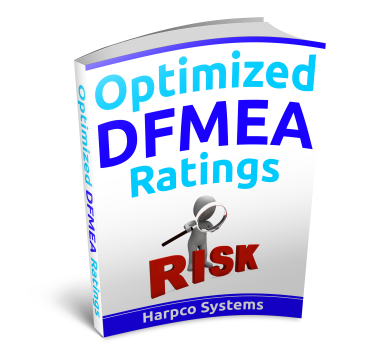Note: This article originally appeared in Quality Magazine under the title “Quality 101: Demystifying Design FMEAs”
Optimized Method For Establishing Design FMEA Ratings Part II
by Richard Harpster, President of Harpco Systems
Establishing the Design FMEA Occurrence Rating
The second rating that must be determined is the occurrence rating. The occurrence rating in the Design FMEA is the rating that corresponds to the probability that the failure mode will occur due to the cause. In the example provided, an occurrence rating must be established for the probability of the component failing because the component material has been specified too thin. An occurrence rating must also be established for the probability of the component failing because the component material type has been specified incorrectly. A typical occurrence rating table follows:
| Rating | Criteria: Probability of Occurrence |
| 10 | >/= 100 per thousand vehicles/items. |
| 9 | 50 per thousand vehicles/items. |
| 8 | 20 per thousand vehicles/items. |
| 7 | 10 per thousand vehicles/items. |
| 6 | 5 per thousand vehicles/items. |
| 5 | 2 per thousand vehicles/items. |
| 4 | 1 per thousand vehicles/items. |
| 3 | 0.5 per thousand vehicles/items. |
| 2 | Greater than 0 but less than 0.1 per thousand vehicles/items. |
| 1 | Failure is unlikely. |
In our example, we are doing a durability test to assess the adequacy of our material thickness and material type specifications. If this were a complete Design FMEA, we might have 20 or more specifications that control whether or not the component will structurally fail due to road impact forces. It is also quite possible that when we run the durability tests we may not even know where these specifications are when we run the tests. Consequently, if failures occur when the tests are run we will have a probability of component structural failure due to road load impacts but will not have what the Design FMEA is asking us for: the probability of the failure mode due to each of the causes. Unfortunately, finding oneself without good objective data to establish the occurrence ratings occurs more often than not when trying to establish occurrence ratings for a Design FMEA.
If you do not have good objective data to establish the probability of the failure mode due to the cause that you are trying to develop the rating for, the following methodology should be used:
- When trying to determine the occurrence rating, one should include several types of information including design control results and the performance of similar products in the field. Often times the information describes the probability of the failure mode occurring but is insufficient to develop an accurate rating for each failure mode/failure cause relationship.
- In these cases, the probability of the failure mode should be rated first and this rating used to set the maximum rating for any of the failure causes for the failure mode.
- Assign the failure mode probability rating to any cause that you believe is a primary contributor to the probability of the failure that you are experiencing.
- Assign the rating of 1 to all other causes linked to the failure mode.
In the example provided, the durability tests were conducted and found that component structural failure due to road load impacts could be expected at a probability of 1 per thousand with the current design. Based on experience, the designers had confidence in the thickness specification but believed the material type selection had property specifications that are too wide and that at the edges of the specifications may be prone to failure. Consequently, an occurrence of 1 was assigned to the material thickness specification cause and a rating of 4 to the material type specification cause.
Want to save this whole article in your files?
Click the book and we’ll send it to your email:
Note:
In Part I of this paper DFMEA Severity Ratings are explained:
Establishing Design FMEA Ratings Part I
In Part III, the limitations of RPN and SxO ratings are discussed:
Establishing Design FMEA Ratings Part III
“Harpco breaks down the barriers and corrects the pitfalls so companies can reap the full benefits of FMEA. Classroom training not only properly teaches FMEA, but participants actually build their business’s FMEA as they go and are often blown away by how much work got accomplished. Harpco Systems has become known as the Modern FMEA for a reason. Its structured, simplified and sustainable.”
“We used QPlus to achieve Q1 and ISO 16949 successfully at the Ford Motor Co. Monroe BAO Plant. The software promoted linked documentation that prevented issues at internal and external audits. Assured the quality documents at the operations production level had all relevant and concurrent information that was reviewed in the program files. QPlus allowed the program members to create a baseline “Hot End Exhaust” database that produced linked documentation from the DFMEA to the production visual aids the operators used to perform correctly.”
“Harpco’s training is first rate and helps develop new ways of thinking about the importance of creating proper specifications early. Separately, I’ve seen firsthand the effectiveness of using their approach in problem solving, helping to advance problems that had reached a stall using traditional methods.”
“We were very fortunate to work with Rich Harpster and his team as we improved our DFMEA process at Calsonic. There is no better teacher, coach, implementer than Rich when it comes to creating a knowledge base for engineers to use in creating part specs to assure that products meet the customer’s requirements. Rich teaches the basics, then he accelerates the FMEA process so that requirements and specs are related in a database that can be continually updated.”
“I would like to thank Harpco Systems for the help, advice and frankly the education in how to design, develop, source and manufacture new to world products.”







